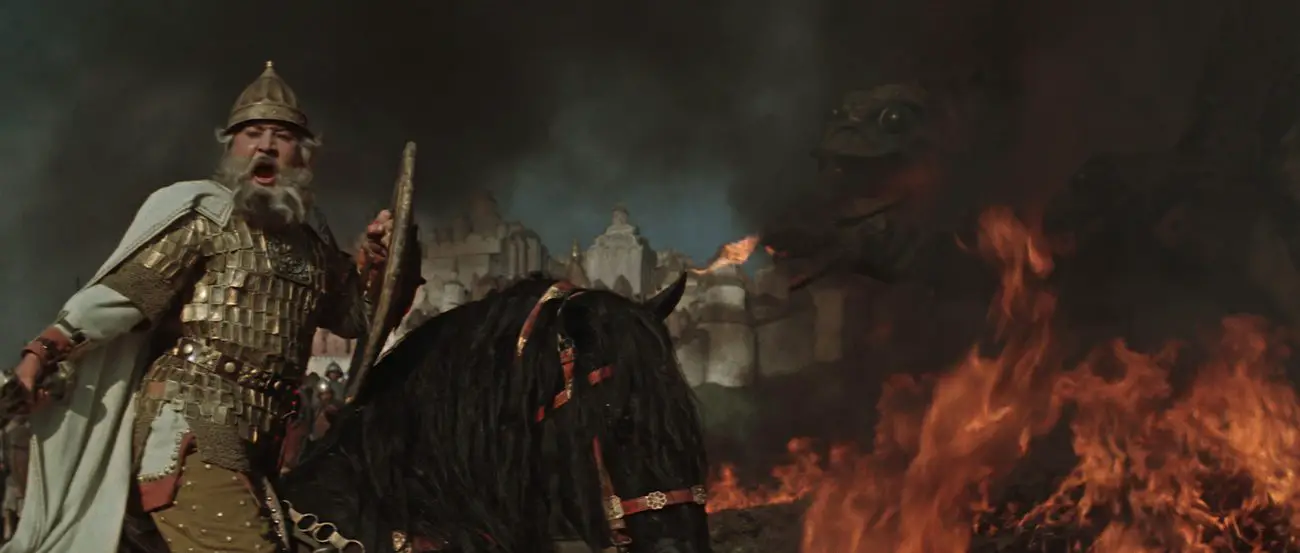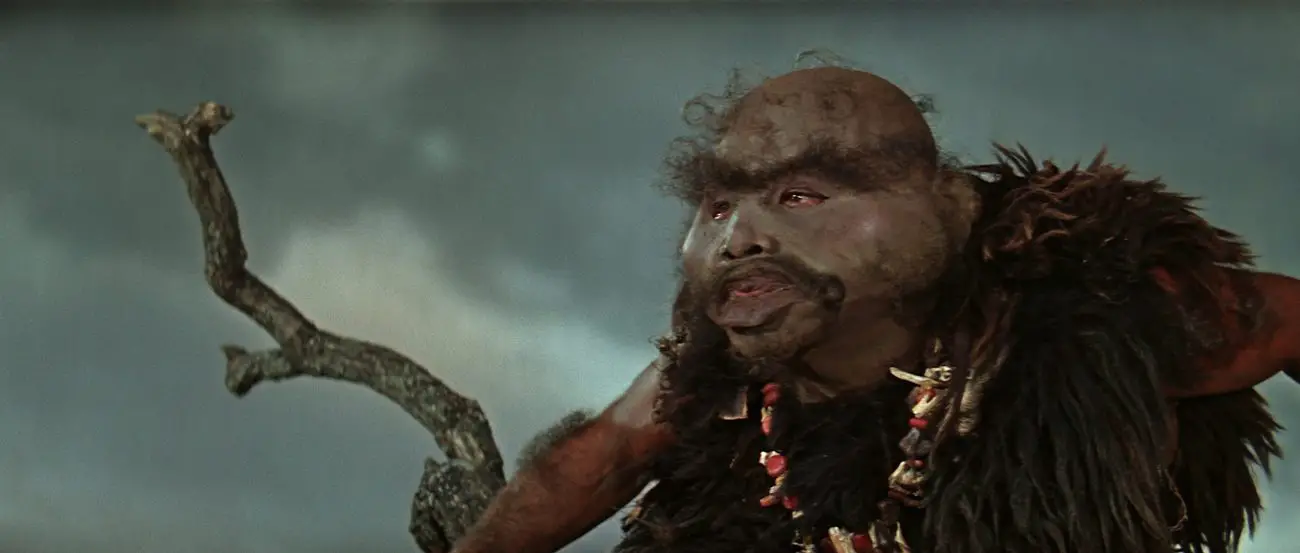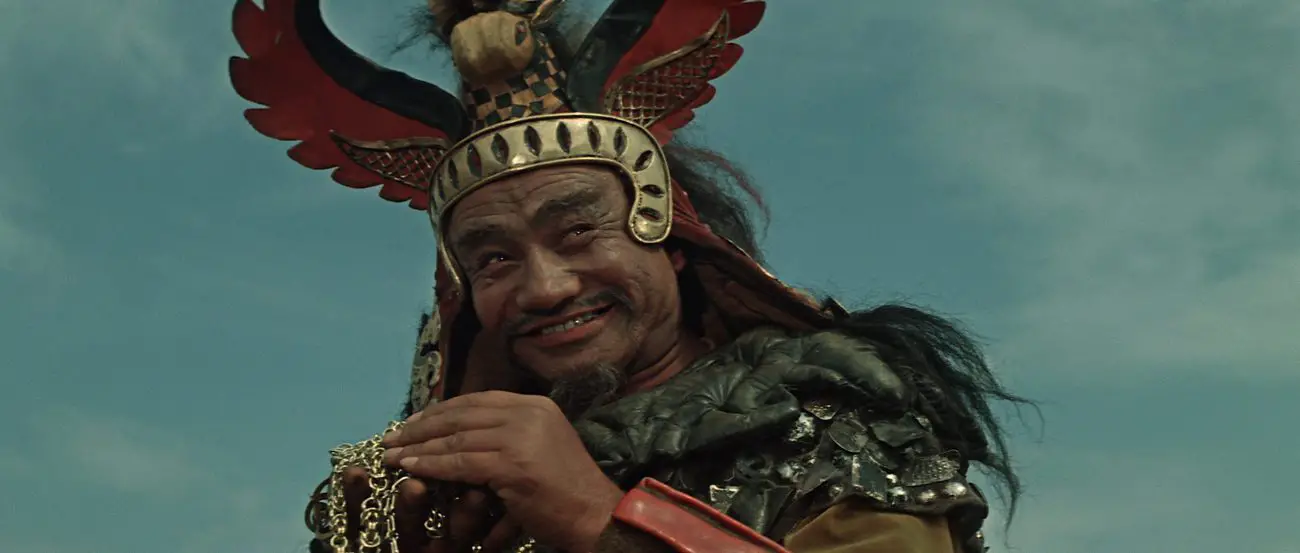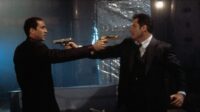Ilya Muromets—the remarkable 1956 medieval fantasy epic directed by legendary Soviet filmmaker Aleksandr Ptushko—is not only a sweeping, towering achievement; it’s also a contemporary treatise on the conflict between Russia and Ukraine. Its 4K remastering by Mosfilm studio from the original 35mm camera negative and its re-release by Deaf Crocodile and Grasshopper films could not be more timely. Historically important as the first Cinemascope film ever produced in the Soviet Union, Ilya Muromets was seen only in the U.S. as the poorly dubbed and edited The Sword and the Dragon (a hatchet job so brutal it landed on an episode of MST3K). But with this new remastering, Ptushko’s visionary film practically leaps off the screen with its stunning visual effects and inspired storytelling.
Ilya Muromets is the name of the film’s titular protagonist (played by Boris Andreyev), a bogatyr warrior and mythic figure in the Kyivan Rus’ culture that pre-dated both modern Ukraine and Russia. As the film begins—thankfully without the dreadful expository voice-over narration and strange editing of The Sword and the Dragon—an aging giant bogatyr Svyatogor gives his sword to some traveling pilgrims to be passed on to a new bogatyr. This scene employs simple forced perspective to convey Svyatogor’s enormity and simple dissolves as he and his horse die and become one with the mountainside. It’s just the first of a quiverful of delightful visual tricks Ptushko has in store.

Meanwhile, Ilya Muromets, betrayed by limbs that have not worked since childhood, is unable to defend his village from the ravaging, pillaging Tugars, who capture his wife Vassilisa, who will bear a son the Tugars raise to fight for their cause. Fortunately, the pilgrims in possession of Svyatogor’s sword find Ilya, cure his paralysis with a magical potion and incantation, and give him the sword. Now possessed with a working limbs, new vigor, and a mission of revenge, Ilya leaves his home to defend Kiev in a decades-long battle from the Tugars. And so, based on a series of famous Russian oral epics known as byliny, Ptushko’s balladic adventure of medieval knights, hostile invaders, fair maidens, strange demons, and, perhaps most impressively, a three-headed fire-breathing dragon, begins.

Along the way, Ilya must battle not only a horde of Tugars and his own lost joust-master son raised by them, but also Nightingale the Robber, by a forest-dwelling creature who blows wind so hard it parts the forest backward; the giant Idolishche Poganoye, a zeppelin-like creature on a moving platform; Likho the One-Eyed; and the Tsar Kalin himself, the Tugar Khan who schemes and plots against Muromets and his people. Ptushko creates a lively rogues’ gallery of creatures with simple makeup and visual tricks designed to emphasize Ilya’s savvy and power. I’ll grant that not everything “works”: you might see a few blades flap like cardboard, a pitched battle consisting of a few gentle slaps, or a dead man scratch his nose. But overall, the effect of Ptushko’s magic is undeniable.

Ilya Muromets‘ epic narrative and dizzying visuals combine a host of practical and optical effects to create a unique vision. One might think of Walt Disney’s appropriations of world folktales, Ray Harryhausen’s stop-motion animatronics, or Alexander Korda’s clever visuals, but Ptushko’s vision and world is uniquely its own. Shot with over 100,000 extras and 10,000 horses—and optical effects to make the battles appear even more populated than that—the film deserves its rightful place in Ptushko’s legacy and world cinema’s history. Restored to its original glory, the film shines as a simple, gorgeous fantasy of quest and battle, one perfect for a Saturday morning with imaginative, open-minded children or like-minded cinephiles eager for fantasy.
But the film works metaphorically as well. Though made in 1956—at the apex of the Cold War—and though depicting battles fought a thousand years earlier—Ilya Muromets nonetheless speaks to today’s world and Russia’s invasion of Ukraine. For centuries the Kyivan Rus’ passed down legends of their hero Ilya Muromets who fought for their people in a land which encompassed modern Ukraine, Russia, and Belarus. For Vladimir Putin, the medieval notion of a united motherland justifies invasion today. Yet Ilya Muromets is a folk hero who fights for his people’s independence against murderous invaders like Tsar Kalin, the Tugar Khan who rapes his wife and raises his own son against him. Were he alive to fight today, we all know whose side Ilya would choose—and it would not be Putin’s.

Ilya Muromets is available from OCN-Vinegar Syndrome’s label in a Blu-ray disc version that contains several special features, including a new commentary track by film historian and author Stephen R. Bissette; scholar Alan Upchurch’s essay on Ptushko from Video Watchdog magazine; and Ptushko’s own essay on the making of the film. The film is also available for digital streaming through Grasshopper Films beginning June 28.
A film that was once considered so bad it was a candidate only for inclusion in the world’s-worst canon of MST3K as The Sword and the Dragon, Ilya Muromets finally has come alive, just like its titular protagonist, in a wholly new, vigorous, colorful, fantastic, and politically relevant remaking. It is, truly and unambiguously, the stuff of legend. It is soon to be followed by another Deaf Crocodile 4K restoration, this of Ptushko’s Finnish/Soviet fantasy epic Sampo (1959), a film that like Ilya Muromets was consigned, as The Day the Earth Froze, to the snark of MST3K. I expect it too will thrive in its new version.



